|
|
|
Published
on 28
Oct 2010
|
All rights reserved.
|
|
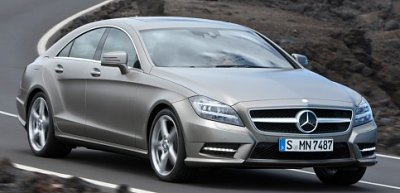 New CLS majors on styling and
efficiency...
New CLS majors on styling and
efficiency...
When
Mercedes introduced
the first CLS in 2004, it was a risky attempt. No one knew whether the
market would receive a four-door sedan shaped like a coupe. It offered
less headroom and poorer visibility than conventional sedans. It
offered no more performance than the E-class on which it was based. It
steered and maneuvered just marginally sharper. In fact, the CLS was
all about looks. Mercedes was brave to approve a very radical exterior
design that raised many eyebrows of traditionalists - including me.
Swoopy roof line and banana-shape side profile differed it from
anything on the road. It looked odd in the first set of official
pictures, but once we saw it fresh on road, we could not help falling
in love with it. You can't find any other four-door as striking as this
one.
The bold attempt paid off. In the next 6 years, more than 170,000
units were sold. Rivals started realizing four-door coupe is a new way.
Volkswagen was the first to copy its idea to Passat CC. Aston Martin
followed with Rapide. Hyundai shaped its new Sonata like a coupe, too.
However, the biggest threat to Mercedes – as well as the biggest
recognition of its success – comes from its German neighbors. Audi has
just launched A7 to compete head on with the Mercedes. BMW will also
introduce a 6-series-based four-door coupe (as previewed by the Gran
Coupe concept) very soon. After six dominating years, the trend-setter
finally faces its first test. Can it fend off the competition and
maintain its lead in this territory ? Not with the old car, of course.
Fortunately, the second generation CLS arrives just in time.
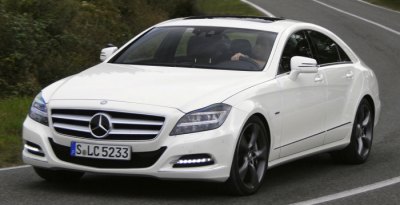 CLS500 has a different front grille
CLS500 has a different front grille
Confusingly,
the second
generation CLS has an "earlier" series name (W218) than the outgoing
car (W219). This might have something to do with the fact that
development of the old car was outsourced to German engineering firm
IVM. Anyway, Mercedes reserved two earlier numbers (W217 and W218) for
its own projects use. Now the latter is used by the second generation
CLS.
The
new car follows the formula set by the old car. It is again built on
the E-class platform, though this time the latest W212 E-class. It
shares the E-class' 2874 mm wheelbase in order to accommodate four
adults comfortably. Copmare with the sedan, its overall length is
increased by 70 mm for styling
purpose. Front and rear tracks are widened by 10 mm and 20 mm
respectively to improve cornering stability. Overall height is lowered
by 55 mm, benefiting both styling and center of gravity. Furthermore,
the driver sits 18 mm lower than in the sedan to give a sportier feel.
All powertrains come straight from the E-class. Suspensions and
steering are also borrowed from the sedan, though they get sportier
tuning. In particular, the geometry of its 3-link strut front
suspensions owes more to the AMG E63. Anyway, if you are familiar with
the old CLS, you won't be surprised by the concept and execution of the
new car.
What it changes the most are in two areas: styling and efficiency.
 Heavy-handed styling loses the
pureness of the original car...
Heavy-handed styling loses the
pureness of the original car...
The CLS is the first Mercedes
new model to introduce
Stuttgart's new
corporate styling theme. Not only characterized by a new forward-facing
grille, its whole body is more aggressively sculpted. Two powerful
crease lines sweep upward and downward respectively across the side and
meet the pronounced rear fenders. Full LED headlamps, angular front
bumper and aggressive air intakes have strong flavors of Sci-Fi.
Unfortunately, the styling gimmicks are probably too heavy handed.
Although we still appreciate its teardrop roof line and banana-shape
side windows, the new CLS has lost the pureness of the original car.
Most motoring writers agree that it is not as beautiful as the old car.
It is more about muscular than feminine beauty, especially the bulldog
front end. That said, its attention to details is amazing. Unlike the
old car, you can hardly pick a small detail not properly finished. This
mean, if you spend more time on it, it may grow on you.
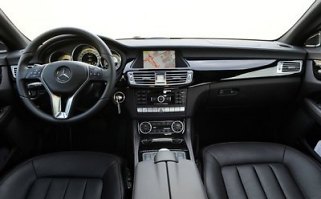
The interior design is similar to exterior. Build quality, functions,
technology and ergonomics are unquestionably improved over the old car,
but it no longer looks as special. While the old dashboard looked like
those of Jaguar, the new one is unmistakably Mercedes. Even though it
is cosmetically different from that of the E-class, you can see the
basic architecture behind is the same.
As before, the low roof line does hamper headroom. 6-footers ave better
to avoid the rear seats, even though they get slightly more leg and
shoulder room than before and a larger door aperture for easier access.
The rear seats are strictly for two, unlike Audi A7 which could
accommodate 3 at a squeeze. However, that should not be a problem to
its target customers, who are likely to have another limousine or SUV
for use in family days. The more important front seats are better, as
they can accommodate the majority of human being. Moreover, with a
520-liter trunk and foldable rear seats, you can hardly criticize its
usability.
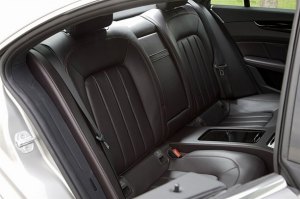
Although
the
new CLS is slightly larger and better built than the old car, its fuel
efficiency is improved by 25 percent, believe or not. This is achieved
by a variety of efficiency-enhancing measures. Let's start from the
chassis. By using aluminum bonnet, trunk lid, front fenders and doors,
its weight is kept unchanged even though torsional rigidity and bending
stiffness have been increased by 6 and 28 percent respectively. More
wind tunnel work reduced its coefficient of drag by 10 percent to 0.26.
New electrical power steering saves 4 percent fuel. Furthermore, the
new CLS employs a series of fuel efficient engines. Most telling of
which is the 2.1-liter twin-turbo diesel. No one could have imagined
Mercedes to install a four-cylinder diesel to a car of this class. This
shows how serious Stuttgart is to raise its fleet average fuel economy
figure. Anyway, the small diesel produces some 204 horsepower and an
impressive 369 lb-ft of torque, enabling CLS250CDI to do 0-60 mph in a
respectable 7.1 seconds. It is capable of 55.3 mpg (EU combined cycle)
and emits only 135g/km of CO2.
The direct-injected 3.5-liter petrol V6 of CLS350CGI is all-new. It
runs a 60-degree V-angle and many fuel saving features, such as the 3rd
generation spray-guided direct injection with piezo injectors,
dual-variable cam phasing, multi-spark technology (enables up to 4
sparks in 1ms for better controlling combustion), lower friction moving
parts, on-demand oil pump and alternator and automatic start-stop.
Output boosted to 306 hp while fuel consumption is reduced by 25
percent (EU combined cycle improved from 31 mpg to 41.5 mpg). CO2
emission is cut from 217g to merely 159g per 100km. For comparison, an
Audi A7 3.0TFSI returns 34.4 mpg and 190g of CO2.
One can see how green the Mercedes is.
However, the lack of low-down torque means the petrol V6 needs to be
revved harder and therefore noisier than the updated 3.0-liter turbo
diesel V6 of CLS350CDI. The latter has its output lifted from 231 hp to
265 hp, accompany with 457 lb-ft of torque. It takes identical time to
go from zero to sixty, but in the real world it feels faster - more
effortless to be fast - than the petrol V6. It also gets improved
combustion and auto start-stop to boost fuel economy. This should be
the pick of the range.
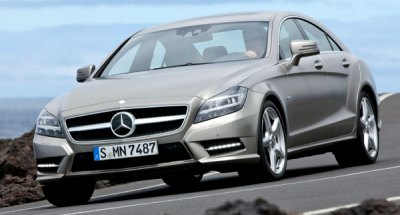
For a car so large, it is admirably
agile.
Nevertheless, if budget is no constraint, we will definitely pick the
range-topping CLS500. Its new 4.7-liter direct-injected twin-turbo V8
replaces the outgoing 5.5-liter naturally aspirated unit. Much the same
fuel-saving technologies found in the new V6 and the addition of
light-pressure turbocharging cuts fuel consumption and emission by 25
percent, while 408 horsepower and much improved low-down torque makes
performance even more effortless. Better still, the addition of
turbocharging did not mask its willingness and sound. It spins happily
to redline and produces a melodious symphony.
The chassis might not have the same leap as the engines, but still a
welcomed improvement from the old car. No matter with mechanical
adaptive damping (on cheaper models) or Airmatic DC adaptive air
springs and adaptive damping (on CLS500), the CLS rides smoothly and
quietly – not in the league of E-class, but outstanding for its class.
You can hardly criticize its handling, too. It grips well, controls its
body roll tightly and stops reassuringly. For a car so large, it is
admirably agile. Moreover, the electrical power steering technology it
adopted is a very good one, offering consistent weighting, linear
response and natural feel. However, if you ask for an interactive
driving experience, the CLS may fail to satisfy you. Old-school power
sliding is strictly ruled out by its intrusive ESP stability control.
Its suspension setting could be sportier as well. Apparently, that room
is left for the AMG version.
Being a crossover between sedan and coupe, the CLS is probably the best
compromise. Although the second generation may not be as beautiful as
the old one, it is better built, better to drive and far greener to
run. Mercedes has raised the bar again. Audi and BMW will be difficult
to beat it. |
Verdict:      |
Published
on 20
Jan 2011
|
All rights reserved.
|
|
CLS63 AMG
|
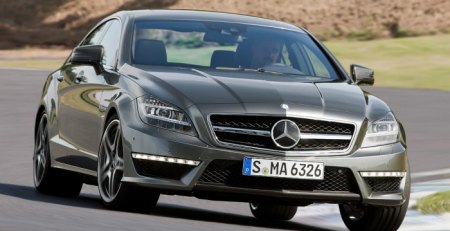
In a bid to raise its price
and image, Mercedes said the new
CLS63 AMG should not be pitched against E-segment rivals like Jaguar
XFR but the even pricier Porsche Panamera Turbo. That car
is the highest performance sedan in the world today, combining a
3.9-second 0-60 mph sprint and 188 mph top speed. The new CLS63 is not
that fast, but very close indeed. With optional performance pack
equipped, it runs from stationary to 60 mph in 4.1 seconds and tops an
electronically limited 186 mph on Autobahn. Taking the Porsche's
4-wheel-drive factor out of account, I would say their overall
performance are closely matched.
The fact that the new AMG is able to deliver such performance – which
is again slightly quicker than its predecessor – must thanks to the new
M157 direct-injected twin-turbo V8. It's basically the same unit fitted
to S63 and CL63 AMG, having a 5.5-liter capacity which contradicts to
the car's name. Due to the more confined space in the engine
compartment of CLS, its exhaust pipes have to be rerouted, causing a
loss of about 20 hp. Still, no one can describe 525 horsepower and 516
pound-feet of torque as insufficient. Moreover, if you tick the
optional performance pack, its ECU will dial up the boost limit from
1.0 to 1.3 bar, releasing 557 hp and 590 lbft. That easily eclipses the
Panamera's 500 hp and 516 lbft.

Just as we have found out in S63 and CL63, the biturbo V8 here is
amazingly torquey, much more so than the outgoing 6.2-liter naturally
aspirated unit. Where the old torque delivery increased in function of
rev, the new engine produces mountains of torque anywhere, anytime.
This gives it superior real-world performance. The less demand for rev,
in addition to auto stop-start, also helps the new car to reduce fuel
consumption by a whopping 32 percent.
For a turbocharged motor, its throttle response is surprisingly sharp.
Turbo lag is virtually non-existent. The only drawback is a slight loss
of aural excitement, yet AMG has done an admirable job to keep the loss
to minimum. This mean, if you have never heard the old V8, you are
going to be thrilled with the new exhaust roar.
However, the biggest progress of the new CLS63 is not engine, but the
sportier manner and sharper response built into the car. By replacing
the old automatic transmission with 7-speed MCT unit, which uses a
computer-controlled wet clutch instead of torque converter, its
gearshift response is greatly speeded up. It even allows some very
aggressive shift patterns, such as Sport+ and Race Start (which comes
with launch control) to deliver a hardcore manner never heard of.
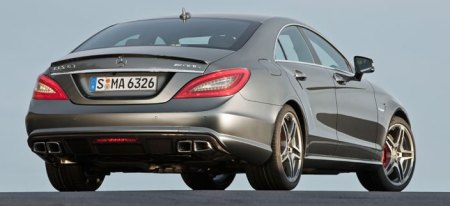
The steering is another area for amazement. It is sharp, quick and
accurate like no other big AMG models before. It's not very weighty,
but it telegraphs the road imperfection and camber into the driver's
hands honestly, which is exactly what Panamera infamously lack of. What
has AMG done ? Quite a lot. Apart from quickening the steering ratio by
22 percent compared with the regular CLS, it also overhauled the front
suspensions. New control arms extend its front track by 25 mm and give
it sportier geometry (more negative camber) to deal with high g-force.
Most important is perhaps ditching the front suspensions' adaptive air
springs for stiff steel springs, so to ensure a direct connection
between the road and the driver. No wonder it offers more feedback to
the driver than Panamera, no matter from the seat of the pants or the
steering wheel.
Other chassis modifications are more predictable, including stiffer
suspension setting, massive rubbers and brakes. On the road, the new
CLS63 is so much more eager to turn-in, and far easier to place on
winding mountain roads. It displays rock solid body control and immense
braking, so cornering limit is extremely high – so high that you may
need a race track to find out. On the flip side, once its limit of
adhesion is exceeded, its traction control intervenes abruptly to
correct things. Nevertheless, you will again need a race track to find
out.
Traditional AMG customers may take some getting used to its new-found
aggressive manner, especially its firmer ride. Fortunately, switch it
to Comfort mode and it still preserves much of the good ride and
transmission smoothness of the old car. This dual-character lifts it
above all its rivals. Being more inspiring to drive than Porsche
Panamera and much faster than Maserati Quattroporte, it has become the
new benchmark for performance luxury cars. |
Verdict:      |
Published
on 6
Oct 2014
|
All rights reserved.
|
|
CLS facelift 2014
|
|
When the second generation
CLS-class made debut 4 years ago, I was a bit disappointed with its
styling,
especially concerning its "bulldog front end" (see the old review
above). In fact, all Mercedes designed in that era were misguided,
using too much angular features to express a message of
aggression. Fortunately, Stuttgart has found a new direction recently.
The 2012 A-class introduced a new corporate face that has since
expanded to CLA-class,
E-class, C-class and now also CLS-class. Its radial mesh grille,
sculpted front bumper and stylish LED headlamps improve a lot the
aesthetic of
the front end, which is finally well matched to the rest of the body
and makes the CLS the most beautiful 4-door on the market. The AMG
model (pictured at the bottom) gets a different bumper again. The
Shooting Brake gets the same treatment as the sedan.
Offering more rear headroom and luggage space yet looking even more
stylish than the 4-door, it is one of the very few estates I would
recommend over their equivalent sedans.
Changes inside the cabin is more subtle. The infotainment screen, which
used to be recessed in the center console, is now free-standing above
the console, as in the new C-class. It is not only larger but also more
ergonomically positioned. The controls and the infotainment system
itself have been updated to be easier to navigate and to connect to
smartphones or tablets.
On the mechanical side, the weakest link, CLS350 petrol, has been
replaced with new model CLS400, whose 333 hp and 354 lbft output boosts
performance significantly, i.e. 0-60 mph takes only 5 seconds flat.
Note that its engine is not the 3.0-liter twin-turbo V6 found on SL400,
but a 3.5-liter version of the same M276 family. Due to using lower
turbo boost pressure, it has exactly the same output figures, but its
maximum torque is available from 1200 rpm, 400 rpm earlier than the
smaller engine. Another important change is the introduction of
9G-Tronic transmission, whose extra ratios improve both fuel economy
and acceleration. Strangely, the new CLS400 is the only non-AMG model
using the older 7G-Tronic Plus gearbox. Even the more powerful CLS500
has been upgraded to the new 9-speed unit. Mercedes' powertrain
strategy is a mess!
The CLS can't quite match BMW 6-Series Gran Coupe for handling. It also
trails Audi A7 for space and refinement. However, thanks to the latest
update it is capable to topple its rivals in terms of styling and
performance. Meanwhile, the AMG model CLS63 is still our top choice of
the class thanks to its mighty engine, performance and character.
|
Verdict:     |
|
|
|
|
|
|
|
|
|
|
| CLS350 |
2010
|
Front-engined,
RWD
|
| Steel monocoque |
| Mainly steel |
| 4940 / 1881 / 1416 mm |
| 2874 mm |
V6, 60-degree
|
| 3498 cc |
DOHC 24 valves, DVVT
|
VIM
|
| DI |
306 hp
|
273 lbft
|
7-speed automatic
|
F: 3-link strut
R: multi-link
|
Mechanical adaptive damping
|
245/45ZR17
|
| 1660 kg |
| 155 mph (limited) |
5.8 (c)
|
| - |
|
| CLS400 (4matic)
|
2014
|
Front-engined,
RWD (4WD)
|
| Steel monocoque |
| Mainly steel |
| 4937 / 1881 / 1418 mm |
| 2874 mm |
V6, 60-degree
|
| 3498 cc |
DOHC 24 valves, DVVT
|
Twin-turbo
|
| DI |
333 hp
|
354 lbft
|
7-speed automatic
|
F: 3-link strut
R: multi-link
|
Mechanical adaptive damping
|
F: 255/35ZR19
R: 285/30ZR19
|
1700 kg (1760 kg)
|
| 155 mph (limited) |
5.0 (c) (5.1*)
|
| (12.9*) |
|
| CLS500 |
2010
|
Front-engined,
RWD
|
| Steel monocoque |
| Mainly steel |
| 4940 / 1881 / 1416 mm |
| 2874 mm |
V8, 90-degree
|
| 4663 cc |
DOHC 32 valves, DVVT
|
Twin-turbo
|
| DI |
408 hp
|
442 lbft
|
7-speed automatic
|
F: 3-link strut
R: multi-link
|
Adaptive air spring +
damping
|
255/40ZR18
|
| 1815 kg |
| 155 mph (limited) |
5.0 (c) / 4.2*
|
| 10.2* |
|
|
|
|
|
Performance
tested by: *C&D
|
|
|
|
|
|
|
| CLS500 |
2014
|
Front-engined,
RWD
|
| Steel monocoque |
| Mainly steel |
| 4937 / 1881 / 1418 mm |
| 2874 mm |
V8, 90-degree
|
| 4663 cc |
DOHC 32 valves, DVVT
|
Twin-turbo
|
| DI |
408 hp
|
442 lbft
|
9-speed automatic
|
F: 3-link strut
R: multi-link
|
Adaptive air spring +
damping
|
255/40ZR18
|
| 1815 kg |
| 155 mph (limited) |
4.6 (c)
|
| - |
|
CLS63 AMG
(Performance pack) |
2011
|
Front-engined,
RWD
|
| Steel monocoque |
| Mainly steel |
| 4995 / 1881 / 1416 mm |
| 2874 mm |
V8, 90-degree
|
| 5461 cc |
DOHC 32 valves, DVVT
|
Twin-turbo
|
| DI |
557 hp
|
590 lbft
|
7-speed MCT
|
F: 3-link strut
R: multi-link
|
Adaptive air spring +
damping
|
F: 255/35ZR19
R: 285/30ZR19
|
| 1870 kg |
| 186 mph (limited) |
4.1 (c) / 3.8*
|
| 8.5* |
|
| CLS63 AMG S 4matic
|
2013
|
Front-engined,
4WD
|
| Steel monocoque |
| Mainly steel |
| 5000 / 1881 / 1412 mm |
| 2874 mm |
V8, 90-degree
|
| 5461 cc |
DOHC 32 valves, DVVT
|
Twin-turbo
|
| DI |
585 hp
|
590 lbft
|
7-speed MCT
|
F: 3-link strut
R: multi-link
|
Adaptive air spring +
damping
|
F: 255/35ZR19
R: 285/30ZR19
|
| 1950 kg |
| 186 mph (limited) |
3.6 (c) / 3.2* / 3.4** / 3.5***
|
7.7* / 8.0** / 7.8***
|
|
|
|
|
|
Performance tested by: *C&D, **MT,
***Auto Bild
|
|
|
|
|
|
|
|
|
Copyright©
1997-2014
by Mark Wan @ AutoZine
|
|